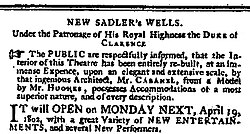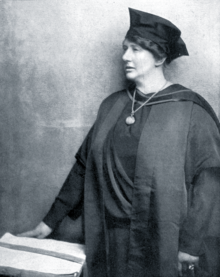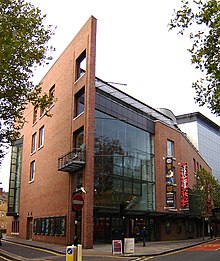Sadler's Wells Theatre
In the mid-19th century, when the law was changed to remove restrictions on staging drama, Sadler's Wells became celebrated for the seasons of plays by Shakespeare and others presented by Samuel Phelps between 1844 and 1862.It consists of two performance spaces: a 1,500-seat main auditorium and the Lilian Baylis Studio, with extensive rehearsal rooms and technical facilities also housed within the site.[13] Under their management the public could hear ballad singers and see jugglers, wrestlers, fighters, dancing dogs and, according to the theatre's 21st-century historian, "even a singing duck".In 1711, after its fashionable clients had taken their trade elsewhere, Sadler's Wells was described in The Inquisitor as "a nursery of debauchery",[16] and the place was frequented by many "unaccountable and disorderly" people.Arundell comments that this engagement added to the prestige of Sadler's Wells "and ultimately benefited the place enormously, for the new Ballet Master was Giuseppe Grimaldi".Rosoman prospered and in the summer of 1764 he announced that Sadler's Wells would be pulled down at the end of the season and rebuilt "in a most elegant manner".[n 2] King took over the management from December 1771,[29] and continued to offer entertainments of the traditional variety – tumblers, singers, acrobats and "Several surprising and pleasing Performances by Messrs Sigels, lately arrived from Paris".The historian Shirley S. Allen writes that such was the remarkable realism in the performance of sea stories that Sadler's Wells became for thirty years the home of the "nautical drama".[42] His productions purged Shakespeare's texts of 18th-century alterations and additions, and he presented the plays with attention to period detail and dramatic veracity.[44] After Phelps's withdrawal in 1862 the theatre presented a variety of shows, but despite appearances by stars such as J. L. Toole, Hermann Vezin and the young Nellie Farren, they made little impact.[45] The building, by that time in a perilous state of repair, was used as a roller-skating rink and for lectures, boxing and wrestling, until in August 1878 Sidney Bateman, who had been running the Lyceum Theatre in the West End, bought the unexpired thirty-three year term of the lease of Sadler's Wells.[47] The theatrical newspaper The Era reported, "The changes made are so remarkable that Sadler's Wells may now claim to be one of the largest and most conveniently-constructed London Theatres".By this time Islington was no longer an isolated village but an inner suburb of the capital, and The Era remarked, "no part of London can be reached with greater facility, as omnibuses, trams, &c, from various directions pass the Angel, not two hundred yards from Sadler's Wells.The historian Philip Temple quotes an earlier writer's comment that despite Bateman's improvements, "in the 1880s the Saturday night gallery contained the most villainous, desperate, hatchet-faced assembly of ruffians to be found in all London".[50] The only major changes to Phipps's building was the addition by the architect Bertie Crewe of a new portico in 1894, aligned to the newly completed Rosebery Avenue.With a four-year sponsorship from the National Westminster Bank, the New Sadler's Wells Opera company focused on operetta, sung in English, in London and on tour.Pinafore, Ruddigore and The Gondoliers, Offenbach's La belle Hélène, Lehár's The Merry Widow and Noël Coward's Bitter Sweet.[77] In 1994 a new chief executive, Ian Albery, led a campaign to transform Sadler's Wells into a purpose-built dance theatre.[79] The opening season included performances by Pina Bausch's Tanztheater Wuppertal, William Forsythe's Ballett Frankfurt, and Rambert Dance.[14] He announced: In accordance with this policy Sadler's Wells has appointed an increasing number of choreographers and other associate artists and has commissioned and produced new work.[14] In 2004 Breakin' Convention joined Sadler's Wells, "representing the origins and evolution of hip hop culture through performance and education.









Sadler's Wells (horse)CoordinatesGrade II listedCapacityRosebery AvenueIslingtonpantomimeShakespeareSamuel PhelpsLilian BaylisOld VicRoyal BalletNational TheatreEnglish National OperaD'Oyly Carte Opera CompanyEnglish Opera GroupBenjamin BrittenHandel Opera SocietyAlvin AileyMerce CunninghamDance Theatre of HarlemLondon Contemporary Dance TheatreBallet RambertPeacock TheatreWest EndSadler's Wells East TheatreStratford, LondonDennis ArundellSurvey of LondonNew RiverClerkenwellTunbridgerope-dancersFour Times of the DayNed Wardburlettaspatent companiesThe TempestGarrick'sDrydenPurcellan opera"Theatre Royal, Drury LaneJosephpantomimesTheatre Royal, HaymarketCharles DibdinSarah SiddonsKing William IVTheatres Act 1843Henry VIIIJ. P. WearingHenry VITitus AndronicusRichard IITroilus and CressidaLaura AddisonGeorge BennettFanny CooperIsabella GlynHamletFalstaffCharles DickensJohn ForsterJ. L. TooleHermann VezinNellie Farrenbaths and washhousesSidney BatemanLyceum TheatreC. J. PhippsBertie CreweThe Eramusic hallporticoThe Daily ChronicleBernard ShawArthur Wing PineroSeymour HicksFirst World WarF. G. M. ChancellorFrank MatchamTwelfth NightJohn GielgudRalph RichardsonToby BelchNinette de ValoisGilbert and SullivanTyrone GuthrieSecond World WarDavid WebsterPeter GrimesJanáčekStravinskySouth BankNorman TuckerStephen ArlenWagnerRing cycleLondon ColiseumNederlands Dans TheaterCologne OperaCamden FestivalNational Westminster BankoperettaLehar'sThe Count of LuxembourgThe MikadoKálmán'sCountess MaritzaH.M.S. PinaforeRuddigoreThe GondoliersOffenbach'sLa belle HélèneThe Merry WidowNoël CowardBitter SweetliquidationIan AlberyGrade II listingPina BauschTanztheater WuppertalWilliam Forsythe'sBallett FrankfurtRoyal Opera